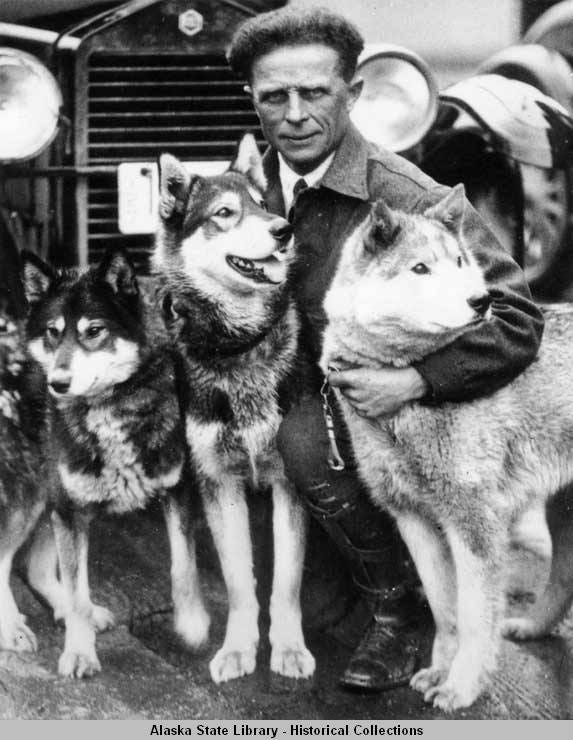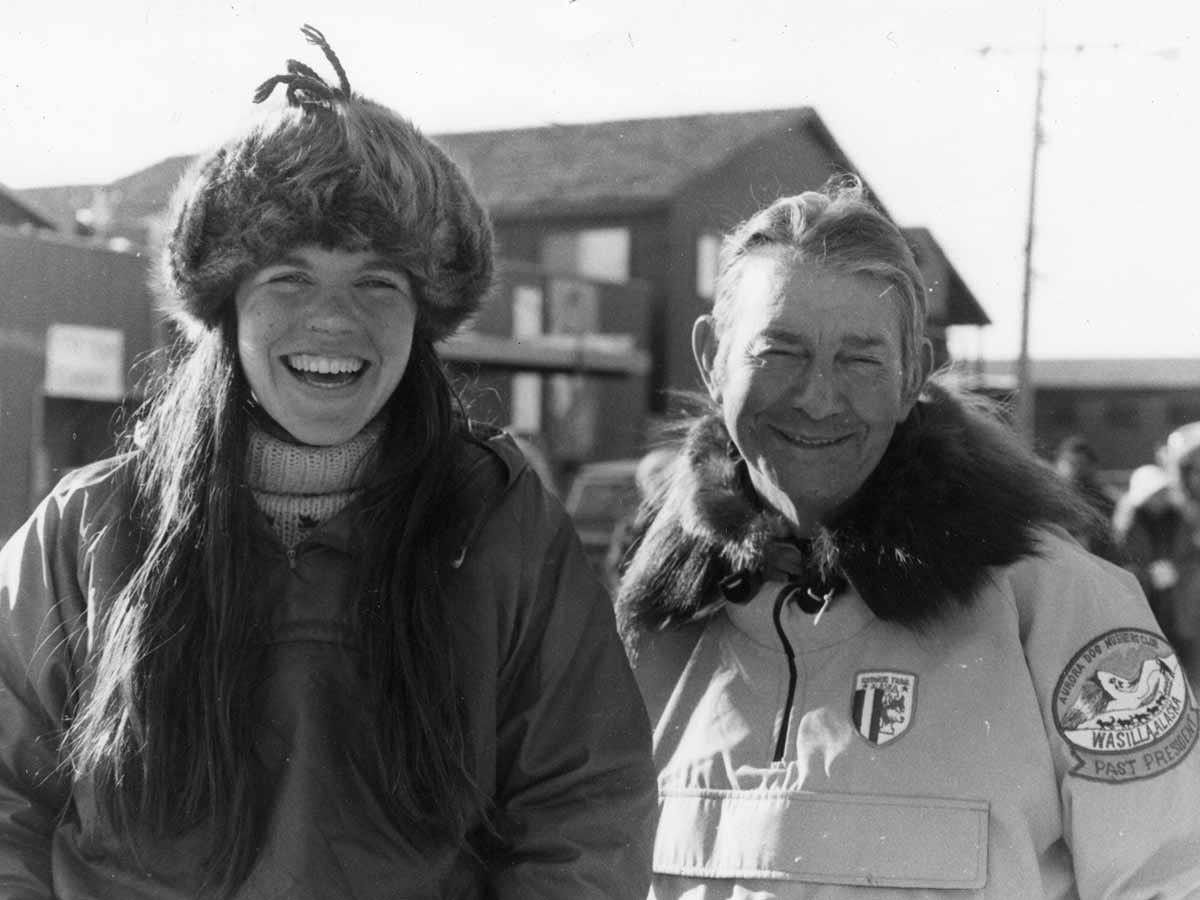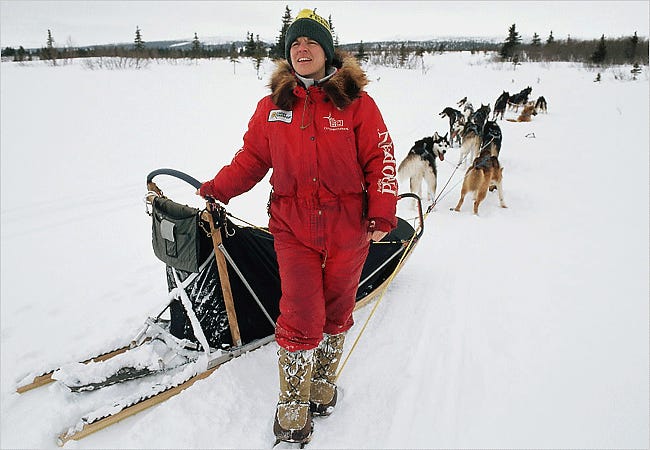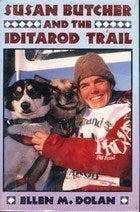Issue No. 26: Of Indomitable Courage & the Iditarod
The story of Susan Butcher and how she earned her place in dog sledding history
To attempt an Iditarod is a true undertaking; to finish an Iditarod is monumental; to win an Iditarod makes one a legend. And, in the 1980s, Butcher became a legend.
A list of elite female athletes would probably include names such as Venus and Serena Williams, Simone Biles, Billie Jean King, Janet Guthrie, and Katie Ledecky among many, many others. I'd like to add one more name to that list: Susan Butcher. Butcher was one of the world's best mushers, known for winning three consecutive Iditarod races, and four out of five sequential years, during the late 1980s.
In this week’s newsletter, you’ll learn a little more about this remarkable woman, the Iditarod, and how she influenced the sport of dog sledding.
Book of the Week: Susan Butcher and the Iditarod Trail by Ellen M. Doman
Artifact of the Week: Governor’s Correspondence re: the 1925 Nome Serum Run
The Legend of Susan Butcher & the Iditarod
What is the Iditarod?
Anyone who knows anything about dog sledding probably remember the 1995 movie Balto, an endearing - if slightly inaccurate - depiction of the 1925 Nome serum run to bring medicine to a diphtheria-stricken town in Alaska. Out of this heroic run sprung the Iditarod, an annual race in Alaska that spans two routes, each one about 1000 miles (1609 km).1 The race occurs at the beginning of each March and lasts between one and two weeks.

The Iditarod requires a great deal of strength, courage, fortitude, love of animals, survival skills, and more in order to succeed. Not everyone can do it, after all. These days, approximately 50 mushers (or dog sledders) attempt the race each year - not all of them finish due to any number of conditions or events including dog injuries, weather, sickness, and exhaustion.
At its inception, mostly men attempted the Iditarod, a grueling race across hundreds of miles of unforgiving and remote terrain, fraught with danger from the weather, flora, and fauna alike. However, in 1985, musher Libby Riddles became the first woman to win the Iditarod. The following year, Susan Butcher began her collection of Iditarod wins. To attempt an Iditarod is a true undertaking; to finish an Iditarod is monumental; to win an Iditarod makes one a legend. And, in the 1980s, Butcher became a legend.
Who Was Susan Butcher?
Susan Butcher was born on December 26, 1954, in Cambridge, Massachusetts. In 1973, she relocated to the Wrangell Mountains in Alaska for a new adventure far away from the East Coast. Butcher’s burgeoning twin passions of dog sledding and dog breeding came to fruition in 1976.
That year, she founded the Trail Breaker Kennel with the goal of training for and running in the Iditarod. Under the tutelage of Joe Redington Sr. - the father of the Iditarod (see footnotes for more information) - Butcher trained with and worked for Redington in exchange for dogs for her team.
Butcher ran her first Iditarod in 1978, placing 19th, becoming the first woman to place in the top 20. The following year, she - alongside Redington, Ray Genet, Brian Okonek, and Robert Stapleton - ascended the slopes of Denali, the highest peak in North America, via dog sled, another first.
From there, Butcher’s star rose. She continued to race in the Iditaroad, steadily increasing her placement. By 1980, the intrepid musher placed in the top 5. Finally, in 1986, Butcher placed first, only the second woman to do so, with a time of 11 days, 15 hours, and 6 minutes.
She won again in 1987, 1988, and 1990, becoming the first musher to win four Iditarods in five consecutive years. That she won four Iditarods is a record matched by only a few.
Butcher continued to race in the Iditarod through the early ‘90s before retiring to manage her Trail Breaker Kennel and raise a family with her husband David. Sadly, she was diagnosed with leukemia and passed away in 2006.
Susan’s Legacy
Susan Butcher’s accomplishments speak for themselves. But even more than her race wins, her determination, tenacity, and grit to succeed in a male-dominated sport made Butcher a force to be reckoned with and a true inspiration for generations.
According to her husband David, in an interview with The New York Times:
“She never thought there should be any barriers for women…She was the first woman ever to dominate [in dog sled racing] and be the best in the world at a sport where men and women compete equally, and the men did not like that…I don’t think she ever thought of herself as a pioneer.”2
Butcher also helped the sport in other ways. Not only did she encourage further interest and enthusiasm, she also championed proper, year-round care and training for the dogs. After all, without dogs, there is no dog racing.
Her husband expressed just how much of an impact Susan made in her life when he said, “She lived more in 51 years than some people do in 100.”3
Book of the Week: Susan Butcher and the Iditarod Trail by Ellen M. Doman
Susan Butcher and the Iditarod Trail was the first book in which I ever learned about this incredible woman. I tore through it multiple times when I was younger, and, for a time, I aspired to be a musher as well. Needless to say, my career path led me along a very different route. The author writes for a younger audience, but I suspect anyone interested in learning more about Susan could do a lot worse!
Artifact of the Week: Governor’s Correspondence re: the 1925 Nome Serum Run
The correspondence shown below was received by then-Alaska governor Scott C. Bone about the diphtheria outbreak in Nome. Delegate Dan Sutherland pleads for assistance as the disease rages throughout Nome.

The telegram reads:
Serious epidemic diptheria [sic] at home necessitates rapid transportation of antitoxin from Nenana to Nome. Stop. Have you any fund to pay for relaying dog teams from Nenana to Nome or would you join me in assuming obligation to be met by Alaska legislature? Stop. Answer quick. (punctuation was added by me)
The 1925 Nome Serum Run saw teams of mushers and their sled dogs transporting thousands of vials of diphtheria antitoxin from Nenana to Nome, a journey of about 675 miles. Mushers completed the run in five-and-a-half days, an utterly remarkable feat, and saved the town.
Artifact Description
Title: Governor Scott C. Bone's correspondence files on the 1925 Serum Run to Nome, January to February 1925.
Date: Winter 1925.
Material: Paper.
Location: Alaska State Archives
Featured image: Susan with Joe Redington Sr. (Trail Breaker Kennel)
Have you ever heard of Susan Butcher? Who’s your favorite female athlete? Was there anyone you looked up to growing up, like I looked up to Butcher? Feel free to leave a comment with your thoughts!
It’s important to note that the Iditarod is more of a commemorative race than the same route used by mushers during the 1925 serum run from Nenana to Nome. The modern-day Iditarod originated with Dorothy Page and Joe Redington Sr., to commemorate the centennial of Alaska’s 1867 entry into the U.S. as a territory.
Viv Bernstein, “Susan Butcher, Pioneer in Sled-Dog Racing, Is Dead at 51,” The New York Times, August 7, 2006.
Ibid.







